The fall season took off like a roar. The last few weeks have been jampacked with music, movies, theater, and art.
October 27 – On the ninth anniversary of Lou Reed’s return to spirit, Laurie Anderson hosted a gathering of what was jokingly called “the cult” – the folks who loved and supported and collaborated with Lou. It was a mash-up of musicians, performers, and Tai Chi aficionados. Master Ren, Lou and Laurie’s teacher, led a rudimentary Tai Chi practice on the roof, while I nibbled crudites and chatted with New York Times reporter Sam Anderson and clocked a crowd that included Michael Imperioli, Julian Schnabel, Timothy Greenfield-Sanders, and Gina Gershon.

Downstairs, Jason Stern (above) – Lou’s tech director and right-hand man – talked about the recent releases from the archives and the exhibition “Caught Between the Twisted Stars” at the New York Public Library, curated by Don Fleming, who also spoke (below).

I chatted with Rameshkar Das (below top), who co-authored Ram Dass’s last couple of books, and Shahzad Izmaily (below right), who plays bass and keyboards with Arooj Aftab.

Stewed bull pizzle was served.

October 28 – The Gold Room at HERE, a very sexy and smart two-actor one-hour play by Jacob Perkins featuring Robert Stanton and Scott Parkinson who shift seamlessly through a dozen characters apiece, beautifully staged by Gus Heagerty.

We had dinner afterwards at Lupe’s with Parkinson (below right, whom we know as Scooter) and Marc Antoine Dupont, Body Electric buddies.

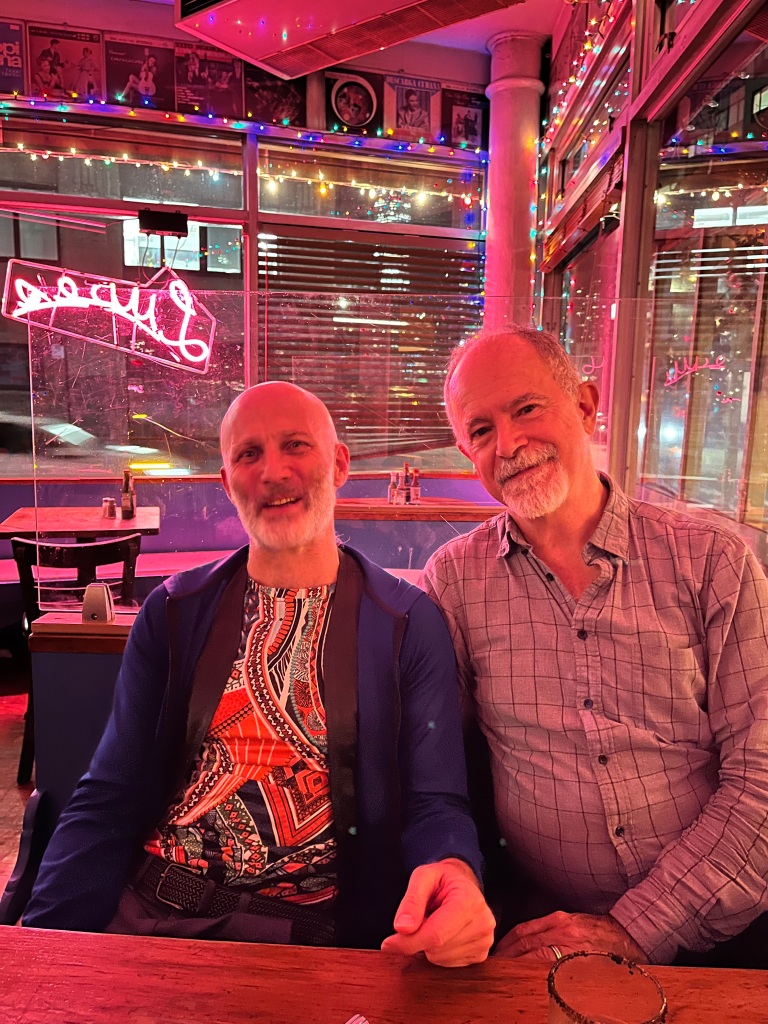
October 29 — Thomas Ostermaier’s bizarre and slapstick-y production of Hamlet started out at the Schaubuhne in Berlin in 2008 and completed its round of touring at Brooklyn Academy of Music. This stripped-down version employs six actors playing all the roles on a stage filled with dirt. The show starts with something that’s not in the play, the burial of Hamlet’s father, so that the wedding banquet literally takes place astride the grave. Many familiar, seemingly crucial scenes and lines were cut. “To be or not to be” occurred several times. And maybe because we were reading the subtitles while the actors spoke German, I encountered lines I swear I’ve never heard before in the umpteen productions of Hamlet I’ve seen in 50 years of theatergoing, such as “Eat a crocodile.” Surely Shakespeare didn’t write that? Guess again.

In the title role, Lars Eidinger has been given license to ham it up and ad-lib like crazy. There were lots of empty seats after intermission, and when some people got up to leave in the middle of the second half he muttered, “Rats leaving a sinking ship!” And as the final scene approached, he roamed around the audience looking for someone to go onstage and fight Laertes in his place. These antics served to keep the show lively, but I’m not sure they illuminated anything about the play. My friend Stephen Greco’s pithy review: “Not enough sadness.”
The lobby of the BAM Harvey hosted an exhibit of pertinent work by women and femme-presenting artists.



October 31 – On Mubi, I watched the early Godard film A Married Woman, from 1964, a love triangle – woman (Macha Meril), her husband and her lover (very handsome Bernard Noel).

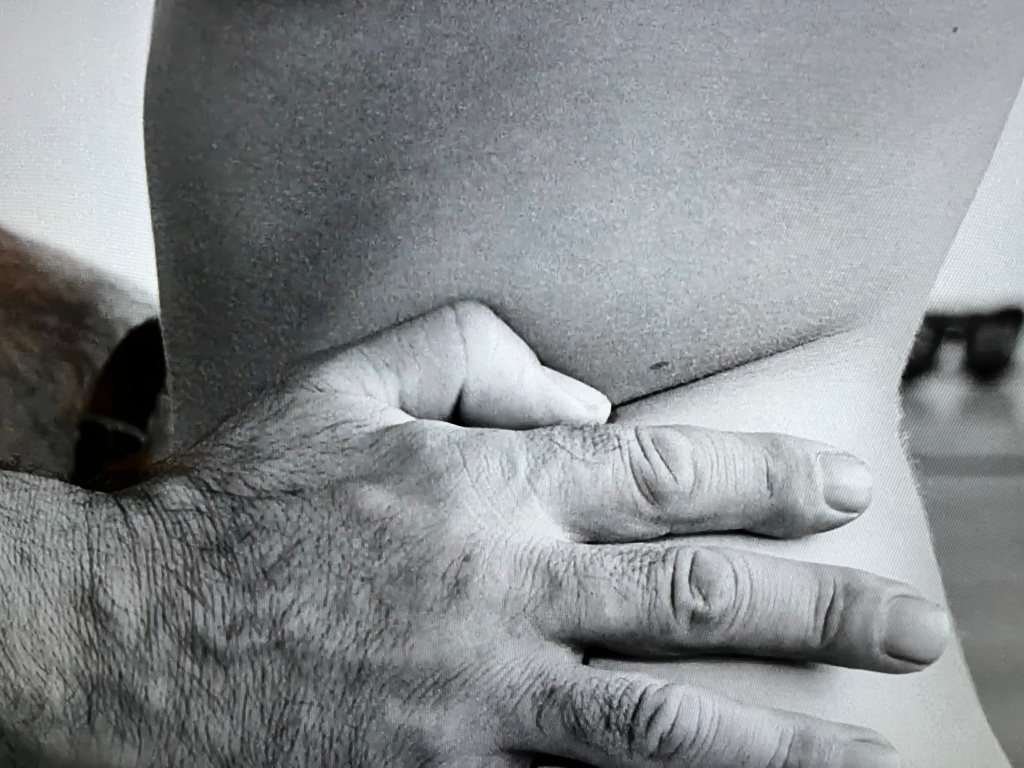
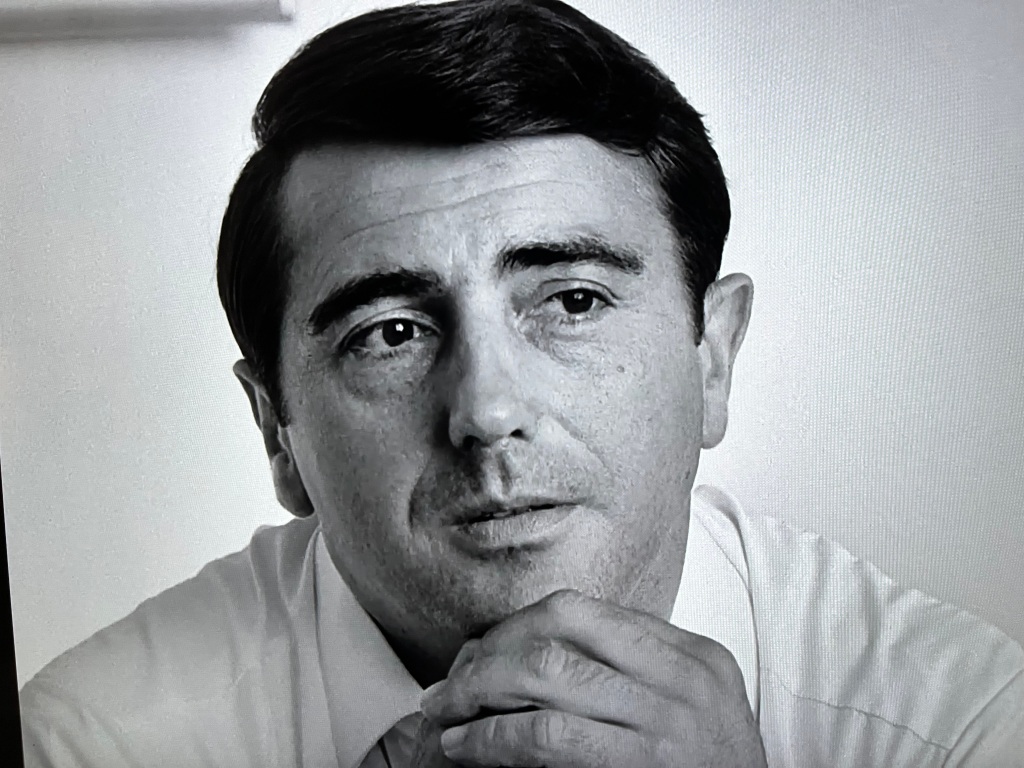
It’s hardly a straightforward narrative but a combination of essay, poem, collage, photo album. Its style is referred to as modernist, I guess because it thrives on the things that film can do – quick cuts, juxtapositions. A recurring motif: zooming in on a public sign so that the few letters showing spell out a pertinent word. Crisp black and white, quite sexy, a lot of skin, and a few very long speeches or long dialogues interspersed with long sections without any faces or words. Very free and inspiring.
November 3 – I went to Playwrights Horizons to see Bruce Norris’s Downstate against my better judgment because I’ve deeply disliked his other plays. Indeed, it turned out to be exactly the kind of play that I hate: ostensibly addressing a provocative subject populated by constructs, not people, behaving implausibly from the get-go, in dialogue that is flagrantly exposition-heavy. The play lost me from the top. No one who works with sex offenders or their victims would ever counsel or approve of an adult survivor meeting a sex offender 1) at the sex offender’s residence 2) with three other residents wandering around in various states of undress eavesdropping. And what wife, accompanying her traumatized husband to such a meeting, would take a banal phone call in the middle of his reading a painful confrontational letter he’s waited his whole life to deliver? No. No. Just no. When the set-up is so flagrantly bogus, it’s hard for me to give credence to anything the playwright is trying to convey. Among the performances, K. Todd Freeman is brilliant as ever, even in a crappy play like this. Mine is clearly not the only possible reaction to Downstate. The friend who recommended it offered this analysis: “Everyone in the play has sexual needs. Some of these needs cause damage to others, others are not totally expressed but all here are punished. I don’t think in any way it’s about excusing or forgiving these people, but it’s about the reality of the desires that exist.” On Twitter, Paul Rudnick paused his Trump-trolling to say, “Bruce Norris’s play Downstate, now at Playwrights Horizons in NYC, is a miracle of writing, acting and directing. It’s harrowing, funny, thrilling and everything that great theater can be. Do not miss.” So go figure.

November 4 — I was delighted to win, through the lottery, a pair of tickets to the first performance of Suzan-Lori Parks’ new shows, Plays for the Plague Year, at Joe’s Pub. It’s a musical starring her (above) as The Writer, comprising the plays she wrote every day for 13 months starting March 13, 2020. The sketches and songs alternate between family life with Hubby (the wonderful Greg Keller) and Son aka Pumpkin Pie (the tall and rambunctious Leland Fowler) and public life – the pandemic, applauding the essential workers, the deaths of Breonna Taylor and George Floyd, RBG and Larry Kramer, her first husband Paul Ocher. “A banquet of the unbearable.” SLP is wonderful. She has a great expressive face, cuts a very charming figure onstage, and plays decent guitar. The scenes are often very short and to the point. She goes to Atlanta to work on a TV show (the Aretha mini-series, presumably) with her husband, and they go to double-check with the real estate agent that the owners of the house they’re renting know that Suzan-Lori is black. The agent hadn’t done so, assumed that because the owners were gay, they would not be bothered. But the couple insist, in such a way that makes you imagine all the unpleasant experiences they’d had in the past that led to ask the question so insistently. The owners did indeed turn out to be cool.
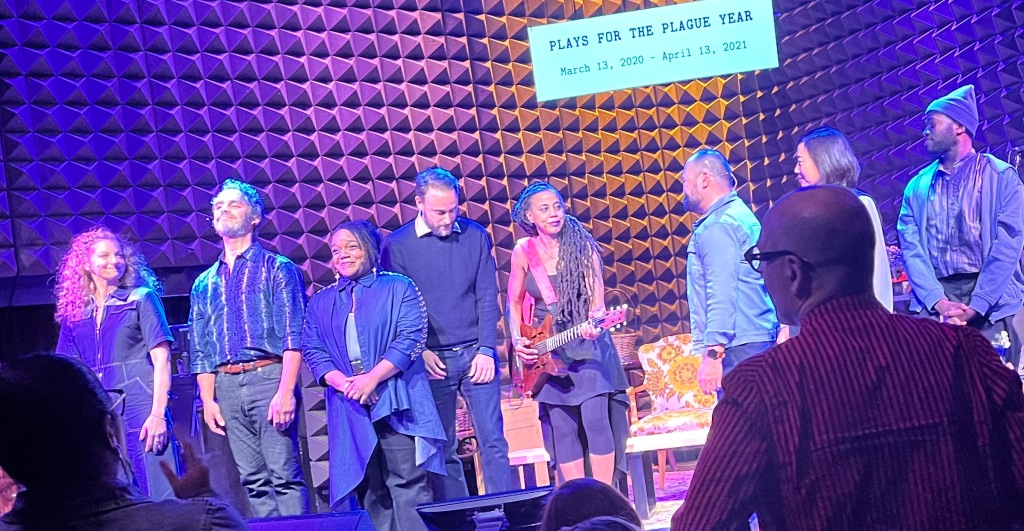
When we walked in, we were handed two slips of paper to be filled out and placed in baskets at intermission: thinking back on the lockdown year, what/who do you want to remember? What/who do you want to forget? The first one she read was, “I want to forget having a threesome with my roommates.” I thought the show was terrific, even if a little long – almost three hours. I think it will have a run.
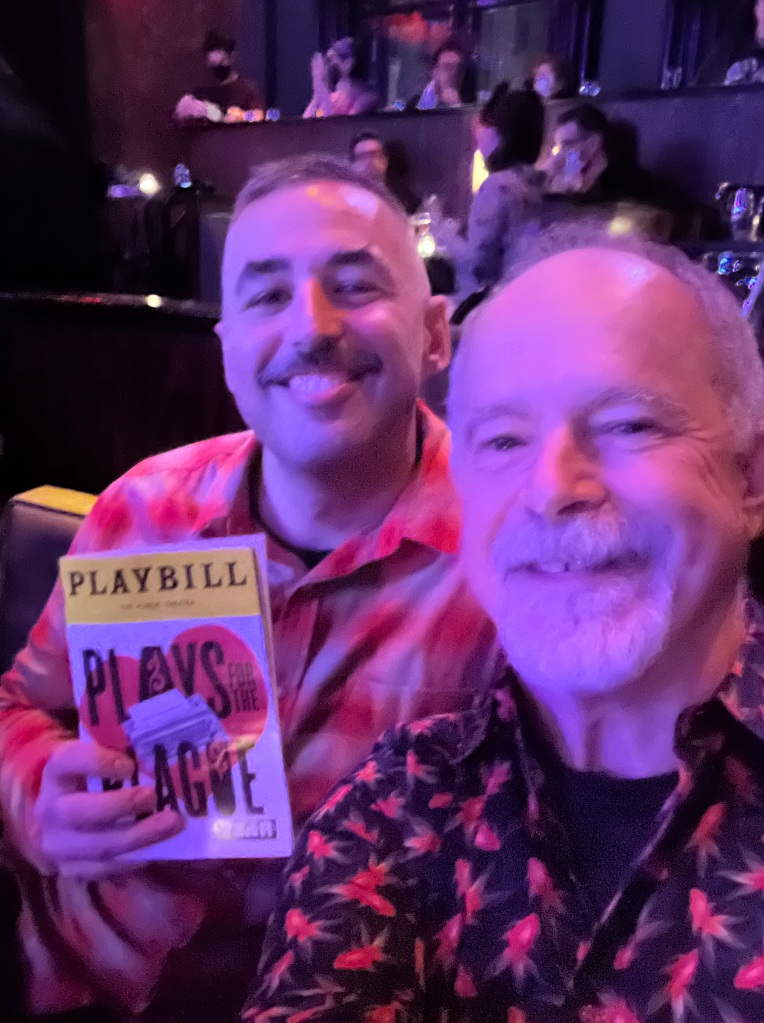
My guest was filmmaker and queer community treasure Adam Baran, who knows Niegel Smith, the director (who stages most of Taylor Mac’s stuff), so I got to meet him. In the lobby they were selling copies of the script. I went to buy one, and a young woman standing next to me jokingly said, “Will you buy one for me?” Impulsively, I did. An actor just out of college at U. of Michigan, she had seen A Raisin in the Sun, which she said was fantastic. Her name is Shaunie Lewis (@itz_shaunie_k on IG). Ask for what you want, girl!

Chilling later with Andy, I shared with him the high points from the new “Super Deluxe” edition of the Beatles’ Revolver that Giles Martin put together, with early, middle, and late takes of “Yellow Submarine,” “And Your Bird Can Sing,” and “Tomorrow Never Knows.”
November 5 — Saturday afternoon was the Dessoff Choirs’ concert at Union Theological Seminary, an acoustically ideal venue for choral music, especially when it can feature the impressive pipe organ. This concert featured two ravishing pieces (a madrigal and a motet) by Vicente Lusitano (1520-1561), the first black composer to have his music published. It was another instance of musical rediscovery by Dessoff’s musical director Malcolm J. Merriwether (below), whose championing of 20th century black composer Margaret Bonds has led to more and more performances of her long-neglected work. (On YouTube, you can watch a half-hour conversation about Lusitano between Merriwether and Joseph McHardy, director of music for His Majesty’s Chapel Royal in London.) The concert continued with the Requiem by Maurice Duruflé with its ravishing polyphonics, its long-held hushed final notes, and a brief interlude with soloist Lucia Bradford and cellist Thapelo Masita. David Enlow masterfully handled the pipe organ throughout.

We had an early dinner afterwards with some of the singers at an Italian place on Broadway. Then we came home just long enough for Andy to change out of his tuxedo to go to see Kimberly Akimbo, which we liked very much. I didn’t see the 2003 iteration of the play, which David Lindsay-Abaire wrote for the amazing Marylouise Burke, but when he and Jeanine Tesori turned it into a musical, I wouldn’t miss it for the world. A teenage girl with that disease that ages you rapidly moves to a new school and falls in with a posse of ice-skating show nerds. Andy had never seen the great Victoria Clark and was blown away by her performance in the title role. As her ne’er-do-well yet infuriatingly charming aunt, Bonnie Milligan steals the show whenever she can; I smell a Tony Award. Stephen Boyer, playing Kimberly’s father, turns out to have a surprisingly lovely singing voice. The high school kids are adorable, especially Justin Cooley as Kimberly’s tuba-playing partner in the great adventure of Living Every Day Like It’s Your Last. I think it’s going to be a hit.

November 6 — Instead of making myself crazy watching the inconclusive results roll in from the midterm election, I took myself to the movies to see Martin McDonagh’s The Banshees of Inisherin. I’m a big fan of McDonagh, and this film reunited the stars of his first full-length feature, the hilarious In Bruges, Colin Farrell and Brendan Gleeson. Here they play best friends in a tiny town on a tiny Irish island in 1923 who have a falling out. The dialogue is absurd and hilarious, both heightened and mundane, the action is violent and mysterious (cf. his play A Behanding in Spokane), the surrounding characters are eccentric, a pet miniature donkey figures in the story, and if you know your McDonagh, animals hardly ever come out well in his work.
To me the spiky buddy-buddy relationship smacks of Sam Shepard (who was a big McDonagh fan) but I just listened to an interview where he said his biggest influences were Mamet and Pinter, that his early attempts at playwriting were all attempts to recreate The Birthday Party and American Buffalo. It doesn’t take a genius to detect in this slim tale a fable about the bloody civil war between North and South Ireland, but the movie doesn’t lean hard on that parallel.
November 10 — On my way home from the post office I decided to stop in at the Museum of Modern Art to check out the exhibition devoted to JAM (Just Above Midtown), the peripatetic gallery founded by Linda Goode Bryant in midtown and eventually relocated downtown, showing a vast array of black artists (superstar David Hammons was an early and very active participant in the gallery’s operations, which were as much about community building as exhibiting art). I like this emerging trend of museums showcasing the work of legendary art spaces as if they were individual artists. I loved the frankness and transparency of this show, which includes a whole wall of JAM’s unpaid bills.
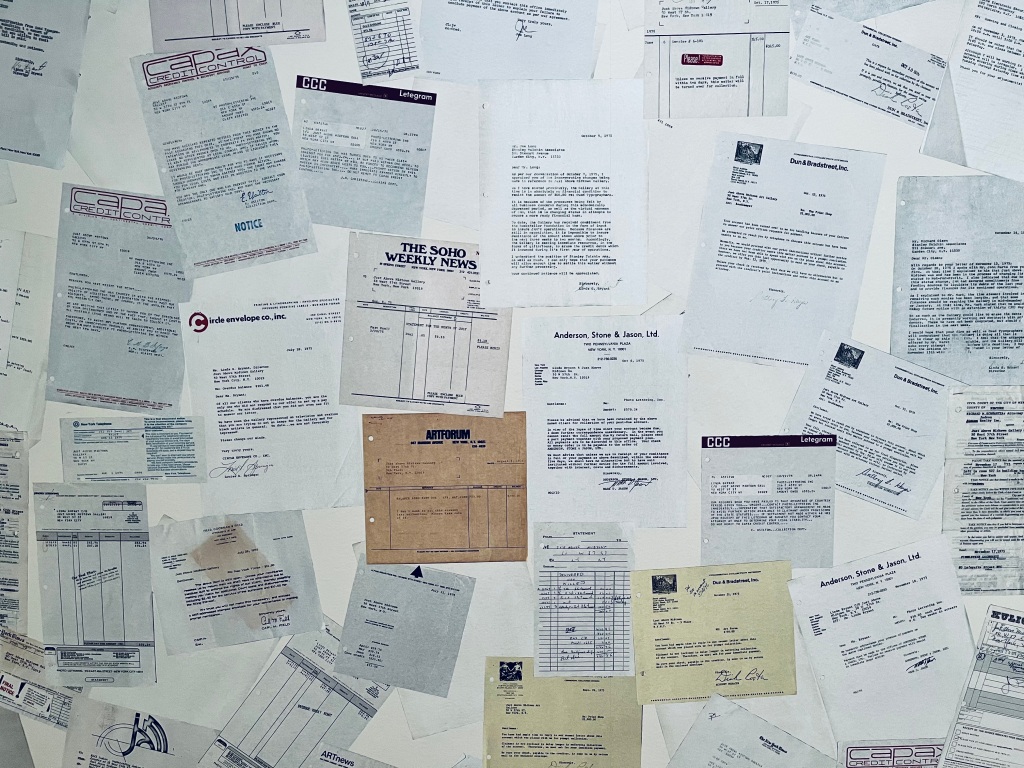

I enjoyed seeing work by artists I’ve admired in other contexts (painter Cynthia Hawkins, illustrator Valerie Maynard) and encountered some striking stuff new to me, like this provocative piece about Indigenous and English language by Edgar Heap of Birds.
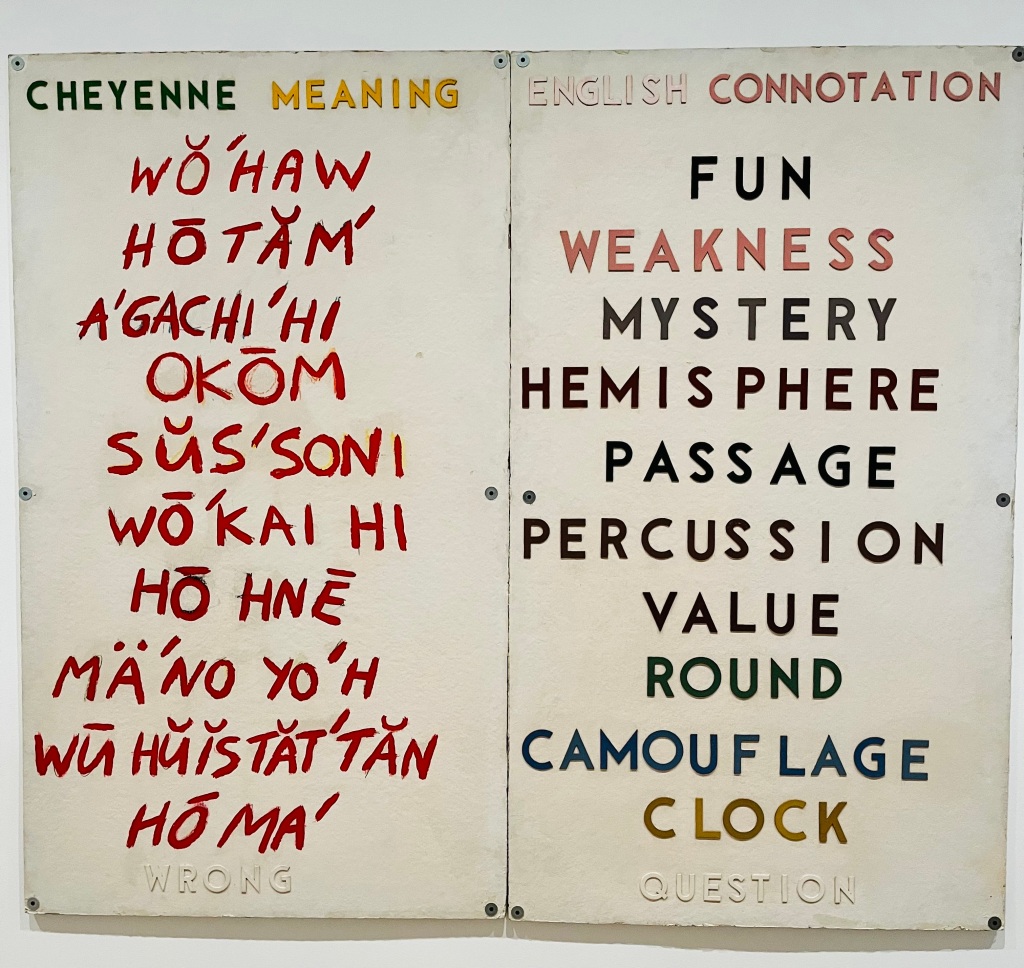

Down the hall from the JAM shows was a retrospective of work by surrealist Meret Oppenheim, about whom I knew almost nothing except for her famous fur-lined teacup. It excited me to witness the range and breadth of her art practice, which explored almost every possible medium without ever resolving into a recognizable style. The pieces that stood out most for me don’t look anything like each other.





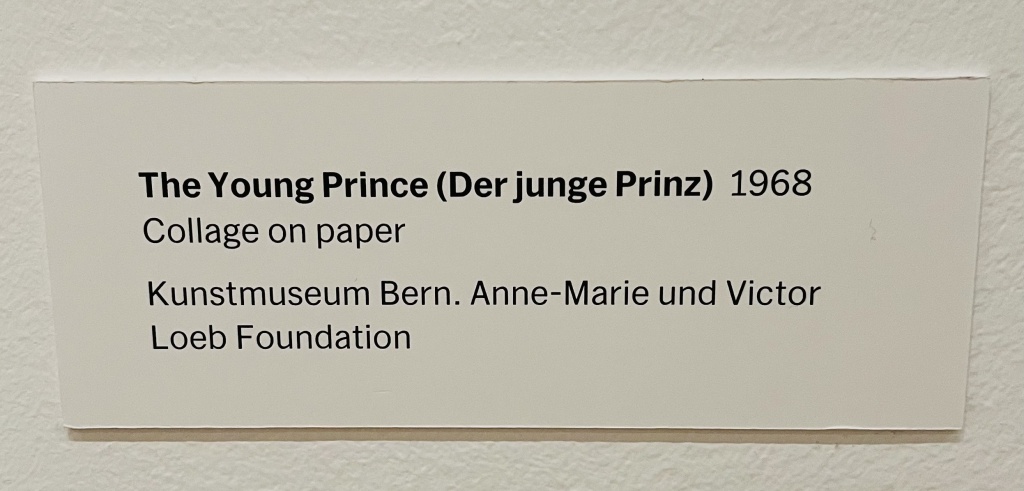


I also enjoyed this canvas, displayed prominently in a hallway next to the atrium where Barbara Krueger’s installation still reigns triumpantly. As the T-shirt says, I too am not interested in competing with anyone. I hope we all make it.

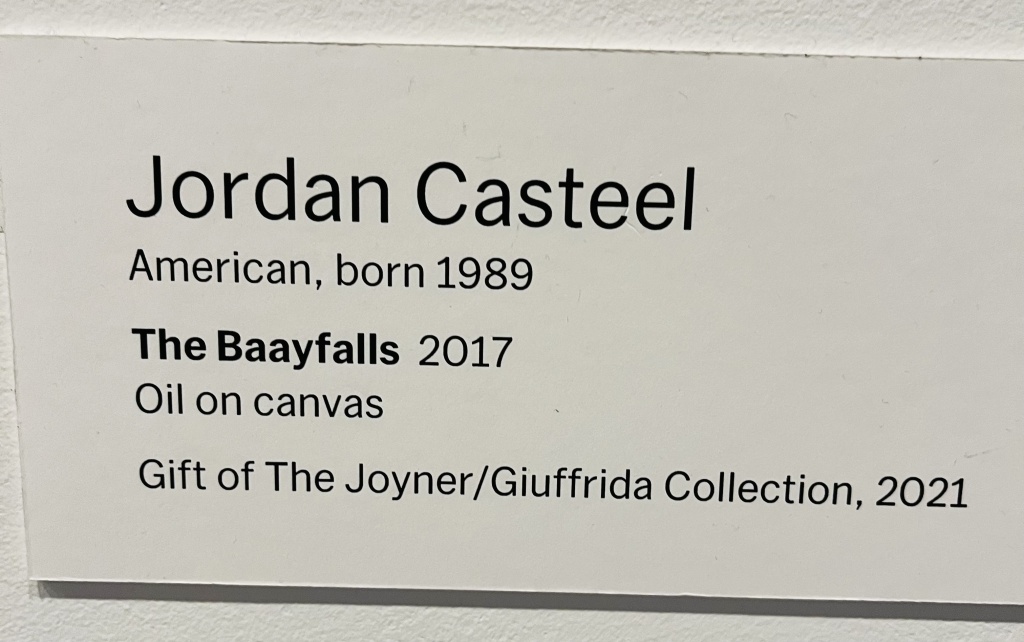
That evening I spent some time poking around MUBI to make the most of my monthly subscription and found myself watching a quirky queer short film called Starfuckers (gay sex workers in Hollywood plot revenge) and then a completely engrossing film I’d never heard of called Lucky, a bravura showcase for Harry Dean Stanton (below) by John Carroll Lynch, son of David Lynch, who plays a small, crucial role.

November 12 – Cameron Crowe’s stage adaptation of his autobiographical movie Almost Famous, with music and lyrics by Tom Kitt, clearly lost some luster in its transfer from the Old Globe in San Diego, where it received ecstatic reviews in 2019, and its opening on Broadway, where it did not. The staging by Jeremy Herrin feels a bit limp. Still, there are pleasures to be had watching the cast inhabit the fantasy of Rock Star Life on the Road, circa 1973. Drew Gehling and Chris Wood have fun fronting the midlevel band that teenage journalist William Miller (Casey Likes) attempts to profile for Rolling Stone; ditto Rob Colletti as Lester Bangs, William’s snarling rock-critic hero-mentor. I kept thinking the show and the music were tame in their depiction of rock ‘n’ roll. But listening to the movie’s original soundtrack album later, I took in the point that the album and the movie make, which is that those rock bands — the Rolling Stones, Led Zeppelin, the Who, Lynard Skynard — didn’t do hardcore headbangers nonstop. They all had songs that inhabited a quieter, acoustic, folky/CSN territory. It was funny to emerge from the theater to commotion in the lobby – there was Cameron Crowe, happy to meet and greet and take selfies with excited fans.

It’s always fun delving into the background after seeing a show, reading reviews and interviews and other source material. A really fun complement to seeing Almost Famous was checking out the Netflix documentary Like a Rolling Stone: The Life and Times of Ben Fong-Torres while writing postcards to Get Out the Vote in Georgia for the Senate runoff race there. Ben Fong-Torres is best-known as a writer and editor in the early days of Rolling Stone (he’s a character in both the movie and the musical Almost Famous) but he has gone on to have an admirable career as a community organizer as well as broadcast journalist. And he kept all the tapes of the musicians he interviewed over the years!

